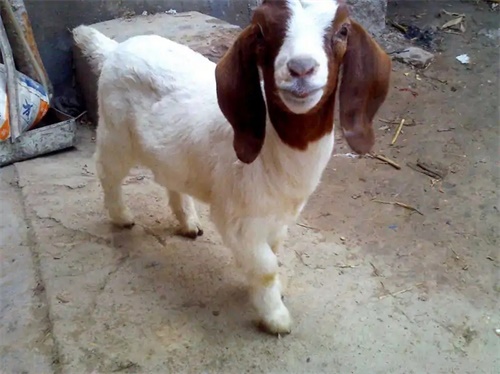Boer goats are well known across the globe for their rapid growth, muscular build, and high meat yield. When crossbred with local goat breeds, they often produce offspring with what is known as hybrid vigor—a genetic advantage that can enhance performance traits such as growth rate and carcass quality. However, while Boer crossbred kids may excel in growth potential, they often struggle with environmental adaptation compared to native breeds. For goat farmers, especially in developing regions or areas with climatic extremes, ensuring the survival of these valuable crossbred kids can be a serious challenge.

In this article, we explore six science-based and practical steps to improve the survival rate of Boer crossbred kids. These methods are rooted in both local experience and international best practices from countries such as South Africa, Australia, and the United States, where Boer goat farming is well established.
Step 1: Ensure Early and Adequate Colostrum Intake
The first few hours after birth are critical for kid survival. One of the most vital actions a farmer can take is ensuring that each newborn kid receives colostrum within the first 1 to 3 hours after birth. Colostrum—the thick, nutrient-rich milk produced by the doe during the first 2–3 days postpartum—contains immunoglobulins, vitamins, minerals, fats, and enzymes that protect the newborn against disease and promote early development.
International research shows that kids who receive colostrum within the first 6 hours have significantly lower mortality and higher weight gain in the first month. In commercial operations in the U.S., it's common to monitor colostrum intake and supplement with commercial colostrum replacers if the mother goat is weak, unwell, or has rejected her offspring.
Tips:
Observe newborns immediately after birth and assist in suckling if needed.
If the mother has no milk or the kid is too weak to nurse, use a stomach tube or syringe to deliver colostrum.
Warm the kid with a heat lamp or wrap in a towel in cold climates before feeding.
Step 2: Precision in Early Management and Temperature Control
The first ten days of life are a make-or-break period for crossbred kids. During this window, environmental factors such as temperature, moisture, and hygiene directly impact survival.
International goat-rearing guidelines recommend keeping indoor temperatures at about 10°C (50°F) during the first 10 days and no lower than 8°C (46°F) thereafter. This is especially crucial in regions where cold snaps are common.
Beyond temperature, the shelter must be dry, clean, and draft-free. Boer crossbred kids tend to have less body fat and thinner coats than indigenous breeds, making them more vulnerable to hypothermia and respiratory infections.
Tips:
Use straw or wood shavings for bedding and change frequently.
Avoid overcrowding in the kidding area.
Install windbreaks or plastic sheeting to prevent drafts.
Step 3: Introduce Early Supplementary Feeding
By the time the kid is 10 days old, it is time to begin introducing supplementary feeds. The goal is not only to support faster growth but to prevent deficiencies in vitamins and trace elements that can impair development.
Begin with high-quality green forage or chopped hay to stimulate rumen development. Around day 15, gradually add a concentrated feed mixture designed for kids, including crushed grains and protein supplements. Clean drinking water and a small basin of weak saline water should be made available to prevent mineral imbalances and unusual feeding behaviors such as soil eating (pica).
In countries like Australia and New Zealand, it is common to use “creep feeding” systems, which allow kids to access special feed in small enclosures inaccessible to adult goats. This ensures that kids are not outcompeted by larger animals for resources.
Tips:
Introduce new feeds slowly to prevent digestive upset.
Provide feeds in shallow trays or pans that are easy for young kids to access.
Maintain feed hygiene to prevent mold and bacterial contamination.
Step 4: Prevent and Control Common Diseases
Due to their relatively weaker immune systems and unfamiliarity with the local microbial environment, Boer crossbred kids are more prone to diseases such as pneumonia, navel ill (umbilical infections), enteritis, and scours (diarrhea).
Preventive measures must be taken from birth. Disinfect the umbilical cord with iodine immediately after birth. Ensure daily cleaning of the pen, and sterilize feeding tools regularly.
Vaccination schedules should be tailored to local disease prevalence. In the United States, for instance, kids are commonly vaccinated against clostridial diseases at 4–6 weeks of age, with boosters given a few weeks later.
Tips:
Perform daily health checks, noting signs like coughing, diarrhea, or lethargy.
Separate sick kids from the group promptly.
Consult a local veterinarian about appropriate vaccines and timing.
Step 5: Timely Weaning and Strategic Deworming
Weaning Boer crossbred kids at the correct time is essential for both survival and long-term productivity. The ideal weaning age is about 60 days (2 months). At this point, the rumen is better developed and kids can derive most of their nutrients from solid feed.
In many regions, gastrointestinal parasites pose a significant threat post-weaning. Crossbred kids, in particular, are susceptible because their immune systems are still maturing. Timely deworming, especially during the weaning transition, is crucial.
International goat health programs recommend:
First deworming 20 days after weaning
Second deworming 60 days after weaning
Seasonal deworming (spring and autumn) for replacement stock
Tips:
Rotate anthelmintic drugs to avoid resistance.
Use fecal egg counts to monitor parasite load if available.
Keep pasture clean and avoid overgrazing.
Step 6: Castrate Male Kids at the Appropriate Time
Unless intended for breeding, male kids from Boer crosses should be castrated. This helps reduce aggression, improves meat quality, and makes the animals easier to manage. After castration, males also tend to deposit fat more efficiently and reach market weight more quickly.
There are several castration methods, including:
Rubber ring (elastrator) within 10 hours of birth
Surgical castration at around 2–3 weeks of age
Farmers in countries like South Africa often choose surgical castration because it allows for visual confirmation and is more effective in older kids. However, this method requires strict hygiene and pain management.
Tips:
Avoid castration during wet or cold weather.
Monitor for infection or swelling post-operation.
Always use clean, disinfected tools.
Conclusion
Raising Boer crossbred kids can be a rewarding but demanding venture. While hybrid vigor offers fast growth and excellent meat characteristics, it also comes with increased management demands—especially during the neonatal and post-weaning phases.
By following the six steps outlined above—ensuring early colostrum intake, maintaining optimal housing, supplementing feeds early, preventing disease, weaning wisely, and castrating properly—farmers can significantly improve survival rates and raise more resilient, productive goats.
Whether you’re managing a small family farm in Southeast Asia or a large commercial operation in Texas, these practices have proven successful across varied environments. Ultimately, it’s not just genetics, but thoughtful care and attention to detail that determine success in raising Boer crossbred goats.
Reference:
Smith, M. C., & Sherman, D. M. (2009). Goat Medicine, 2nd Edition. Wiley-Blackwell.
FAO (2022). “Goat Production and Health in Tropical Regions.”
South African Boer Goat Breeders Association. (2023). Health and Management Guidelines.
tags:
Text link:https://www.bxlultrasound.com/ns/810.html


